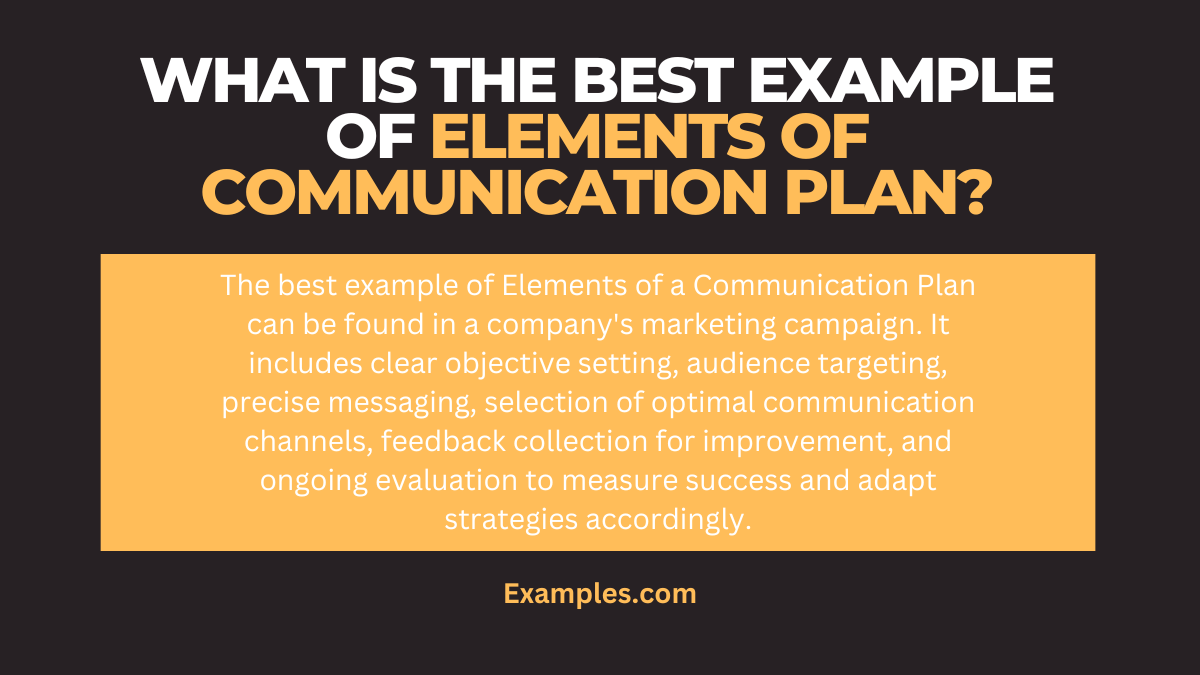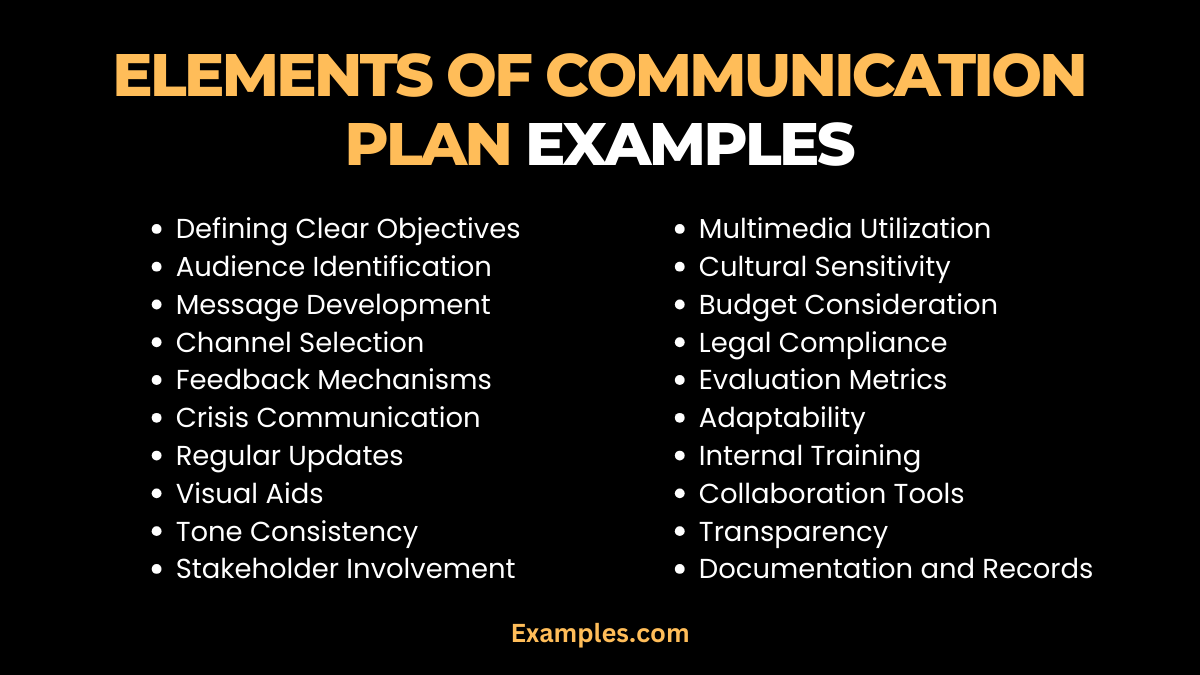19+ Elements of Communication Plan Examples
In the realm of effective organizational management, understanding the Elements of Communication Plan is crucial. This comprehensive guide explores various aspects of communication planning, providing communication examples and methodologies that are pivotal in crafting successful strategies. From Communication Strategy Development to Stakeholder Engagement Strategies, and incorporating Feedback and Evaluation Methods, the guide offers insights into creating a robust marketing communication framework. It’s an essential resource for anyone looking to enhance their communication processes within an organization or project.
Download Elements of a Strategic Communications Plan PDF
What is Elements of Communication Plan?

The Elements of a Communication Plan encompass the key components necessary for crafting effective communication strategies within an organization or project. These elements typically include defining the communication objectives, identifying the target audience, developing clear messages, selecting appropriate channels for dissemination, and establishing feedback mechanisms. Additionally, they involve setting timelines and evaluating the effectiveness of communication efforts, ensuring that the messages are delivered efficiently and achieve the desired impact.
What is the best Example of Elements of Communication Plan?

A prime example of a communication plan is seen in large corporations’ marketing campaigns. These plans typically encompass clear identification of the target audience, creation of tailored messages, and selection of optimal communication channels like social media, press releases, and email marketing. They also involve systematic feedback collection and analysis, allowing for timely adjustments to the strategy. This approach ensures that the marketing messages are effectively communicated, engaging the audience and achieving the set marketing objectives.
20 Elements of Communication Plan Examples

Creating an effective communication plan is key to successful information dissemination and engagement in any organization. A good plan encompasses a thorough understanding of the target audience, clarity in message delivery, and efficient use of communication channels. It also involves regular monitoring and adapting based on feedback. This approach ensures that the communication is impactful and meets its intended goals.
- Defining Clear Objectives: Establishing specific communication goals.
- Audience Identification: Understanding who the message is for.
- Message Development: Crafting clear and effective messages.
- Channel Selection: Choosing the right mediums for communication.
- Feedback Mechanisms: Incorporating ways to receive responses.
- Crisis Communication: Planning for emergency communication.
- Regular Updates: Keeping communication frequent and consistent.
- Visual Aids: Using graphics to enhance understanding.
- Tone Consistency: Maintaining a uniform communication style.
- Stakeholder Involvement: Engaging all relevant parties.
- Multimedia Utilization: Employing various formats like videos.
- Cultural Sensitivity: Adapting communication to diverse audiences.
- Budget Consideration: Allocating resources for communication efforts.
- Legal Compliance: Ensuring communication adheres to regulations.
- Evaluation Metrics: Measuring the effectiveness of communication.
- Adaptability: Being flexible to change strategies.
- Internal Training: Educating team members on communication plans.
- Collaboration Tools: Using technology for team communication.
- Transparency: Being open and clear in messages.
- Documentation and Records: Keeping track of communications.
Elements of Communication Lesson Plan:
Elements of a communication lesson plan in educational settings involve strategic approaches to teaching communication skills effectively. This includes clear objectives, identifying the target audience (students), incorporating interactive teaching methods, and using appropriate educational tools and technologies. Additionally, assessing student understanding through feedback and evaluations is crucial.
- Objective Setting:
- Clarifying lesson goals.
- “Today’s objective is to learn effective public speaking techniques.”
- Interactive Discussions:
- Encouraging student participation.
- “Let’s discuss how body language impacts communication.”
- Role-Playing Activities:
- Simulating real-life communication scenarios.
- “In this role-play, practice resolving a conflict through dialogue.”
- Use of Multimedia:
- Enhancing lessons with visual and audio aids.
- “Watch this video on non-verbal communication cues.”
- Group Projects:
- Promoting collaborative communication skills.
- “Work in groups to create a presentation on effective team communication.”
- Feedback Sessions:
- Providing constructive feedback.
- “Let’s review your presentation and discuss areas for improvement.”
- Peer Review Exercises:
- Learning from fellow students.
- “Exchange your essays with a classmate for peer review.”
- Case Study Analysis:
- Examining real-world examples.
- “Analyze this case study to understand communication breakdowns.”
- Communication Theory Lessons:
- Teaching foundational theories.
- “This lesson covers the basics of communication theory.”
- Technological Communication Tools:
- Utilizing modern communication platforms.
- “Use this app to practice language skills with classmates.
Key Elements of Communication Plan:
The key elements of a communication plan are foundational aspects that ensure effective and efficient information dissemination in any organization. This includes clearly defining the communication objectives, understanding and analyzing the target audience, crafting impactful messages tailored to the audience, and choosing the most suitable communication channels. Additionally, establishing robust feedback mechanisms for continuous improvement, and setting measurable performance metrics are essential. Each element plays a crucial role in the success of the overall communication strategy.
- Objective Setting:
- Clearly define what the plan aims to achieve.
- “Our goal is to increase employee engagement by 30% this quarter.”
- Audience Analysis:
- Understanding who the message is for.
- “This message is targeted at our new interns, focusing on orientation.”
- Message Clarity:
- Ensuring the message is clear and understandable.
- “Let’s ensure our safety procedures are communicated clearly and concisely.”
- Appropriate Channel Use:
- Choosing the right medium for your audience.
- “We will use email for formal communications and Slack for quick updates.”
- Feedback Collection:
- Implementing methods to receive audience feedback.
- “Please fill out this survey to let us know how we can improve.”
- Crisis Management Plan:
- Preparing for emergency communications.
- “In case of an emergency, follow these clearly outlined steps.”
- Consistent Updates:
- Keeping the audience regularly informed.
- “Weekly updates will be provided every Monday morning.”
- Incorporating Visuals:
- Using graphics and visuals to support the message.
- “Our presentation will include infographics to illustrate the data points.”
- Maintaining Tone:
- Ensuring a consistent style and tone in communication.
- “All our customer communications should be friendly and professional.”
- Inclusive Stakeholder Communication:
- Engaging all relevant parties in the communication.
- “We will have a town hall meeting to involve all departments in the decision.
Elements of a Comprehensive Communication Plan

A comprehensive communication plan is a detailed blueprint that guides the entire communication process within an organization. It includes extensive strategies covering all aspects of communication, from defining key messages and identifying target audiences to choosing the most effective channels and tools for dissemination. This plan also emphasizes continuous feedback and adjustment, ensuring that the communication remains effective and relevant.
- Strategic Message Alignment:
- Aligning messages with organizational goals.
- “Our communication aligns with our mission to promote sustainability.”
- In-Depth Audience Research:
- Understanding the needs and preferences of the audience.
- “Research shows our target audience prefers email updates.”
- Multi-Channel Distribution:
- Using various platforms for message dissemination.
- “We’ll distribute this announcement via social media, email, and our website.”
- Regular Communication Audits:
- Evaluating the effectiveness of communication strategies.
- “Our annual audit will assess the impact of our communication plan.”
- Crisis Management Protocols:
- Preparing for potentialcrisis communication .
- “In case of a crisis, follow our predefined communication protocol.”
- Feedback Collection Systems:
- Implementing methods to gather audience feedback.
- “Please provide your feedback through our online survey.”
- Data-Driven Adjustments:
- Using data to refine communication strategies.
- “Data shows a need to increase our social media presence.”
- Interdepartmental Collaboration:
- Ensuring consistent messaging across departments.
- “Let’s coordinate with the marketing team for a unified message.”
- Compliance and Legal Checks:
- Adhering to legal standards in communication.
- “Ensure all our communications comply with industry regulations.”
- Staff Training and Development:
- Equipping employees with necessary communication skills.
- “We offer training sessions to improve internal communication skills.
What are the Elements of a Successful Strategic Communications Plan?
A successful strategic communications plan hinges on several key elements:
-
- Clear Objectives: Defining specific, measurable goals for the communication strategy.
- Target Audience Identification: Understanding who the messages are intended for and tailoring the approach accordingly.
- Key Message Development: Crafting clear, impactful messages that resonate with the audience.
- Channel Selection: Choosing the right platforms to effectively reach the audience.
- Feedback Mechanisms: Implementing tools to gather and analyze feedback for continuous improvement.
- Crisis Communication Strategy: Preparing for potential challenges or emergencies.
- Regular Review and Adaptation: Continuously assessing the plan’s effectiveness and making necessary adjustments.
What are the Important Elements of a Project Communication Plan?
The important elements of a project communication plan include:
- Clear Objectives: Establishing what the communication plan aims to achieve within the project.
- Stakeholder Analysis: Identifying all stakeholders and understanding their communication needs.
- Message Development: Crafting clear and effective messages tailored to the audience.
- Communication Methods and Tools: Choosing appropriate channels and tools for message dissemination.
- Timelines and Frequency: Setting schedules for regular communication updates.
- Roles and Responsibilities: Assigning communication roles to team members.
- Feedback Mechanisms: Implementing processes for collecting and integrating feedback.
- Adaptability: Flexibility to adjust the communication plan as the project evolves.
- Monitoring and Evaluation: Regularly assessing the effectiveness of communication efforts.
- Documentation: Keeping a record of all communications for transparency and reference.



